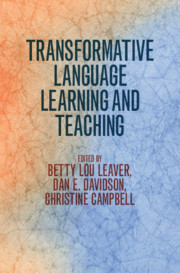Book contents
- Transformative Language Learning and Teaching
- Transformative Language Learning and Teaching
- Copyright page
- Contents
- Figures
- Tables
- Contributors
- Foreword
- Acknowledgments
- Abbreviations
- 1 Introduction
- Part I Theoretical Framework
- Part II Transformative Language Learning and Teaching Applications in Government Programs
- Part III Transformative Language Learning and Teaching Applications in University Programs
- Part IV Transformative Language Learning and Teaching Applications in Immersion Programs
- Part V The Learner
- Part VI Faculty Development
- Part VII Assessment
- References
- Index
1 - Introduction
Published online by Cambridge University Press: 26 January 2021
- Transformative Language Learning and Teaching
- Transformative Language Learning and Teaching
- Copyright page
- Contents
- Figures
- Tables
- Contributors
- Foreword
- Acknowledgments
- Abbreviations
- 1 Introduction
- Part I Theoretical Framework
- Part II Transformative Language Learning and Teaching Applications in Government Programs
- Part III Transformative Language Learning and Teaching Applications in University Programs
- Part IV Transformative Language Learning and Teaching Applications in Immersion Programs
- Part V The Learner
- Part VI Faculty Development
- Part VII Assessment
- References
- Index
Summary
The introduction explains the need for the book, describes its design, and introduces the methodological strands currently exhibited in the programs and curricula of language educators whose teaching reflects transformative education: principles and theory based on the works of (1) Mezirow and his followers Cranton and Taylor, (2) Freire, (3) Vygotsky, (4) Rogers and (5) Boyd and Habermas, (6) Dirkx, and (7) O’Sullivan, among others. The introduction follows the storyline told by the authors of the various chapters, depicting the appearance and growth of transformative language learning and teaching (TLLT), its current manifestations in the classroom, study abroad programs, the community, testing practices, and teacher preparation, and ending with a discussion of the morphing of TLLT’s Mezirowan cognitive base into a more affective and even spiritual approach. How these strands are treated within different educational contexts or treatments are pointed out. The classrooms and programs designed by the book’s authors weave a rich tapestry of variants of transformative education in the classroom, in study abroad programs, in extramural activities, and in the community; how these all exemplify current transformative education practices will be discussed. This chapter also points out the range of languages represented in the volume, including L2, EFL/ESL and bilingual education and how these three generally distinct fields form an organic whole. The intent of the introduction is to provide an overarching framework in which to understand the theory, praxis and programs of transformative education presented in the book.
Keywords
- Type
- Chapter
- Information
- Transformative Language Learning and Teaching , pp. 1 - 10Publisher: Cambridge University PressPrint publication year: 2021

